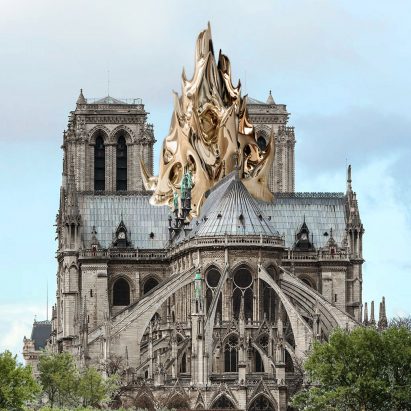
When a part of Notre Dame Cathedral burned, there was an instant, worldwide flood of money inundating a Catholic place of worship. And a national icon. And a place of romance. But more than that, Notre Dame is, by design and history, sacred.
Would the Paris Opera House in flames evoke the gut-crushing pain of the Notre Dame fire? If the Eiffel Tower went up in flames, we would be shocked, but the tragic specter of Notre Dame cut to the quick. Fixing all the broken places—after wars, earthquakes, terrorist attacks—is daunting, tough work. But the destruction of the sacred in our history and midst is different because the sacred is shared in each and every one of us, whether we can rationalize that or not.
I know this because we all felt the punch of pain when the flames of Notre Dame were on full-blast. The carnage revealed a greater truth: There is something sacred, and we all feel its destruction.
But my tribe, architects, largely saw opportunity in disaster. Like the ambulance-chasing doctor in search for a Frankenstein to reanimate, architects almost instantly began to offer up ideas. One of the era’s Starchitects, Sir Norman Foster, almost immediately offered up a design that saw the cathedral as merely a plinth upon which a new crystal palace loft would allow a human view of the human construction of Paris: the ancient font of faith would become a platform for humanity to view humanity, and the beauty we wrought.
Foster guilelessly offered this justification for his ghoulish opportunism: “The decision to hold a competition for the rebuilding of Notre Dame is to be applauded, because it is an acknowledgment of that tradition of new interventions.” Can you say “oxymoron”?
Sure: civilization progresses on the edge of disasters. Wars push technology forward. Diseases force science to extend lives. Poverty and despair make for great artistic inspiration. When bad things happen to good people, if they don’t kill us, they only make us stronger. Yadda. Yadda. Yadda.
But that is not why it broke our hearts to see Notre Dame engulfed in flames. It is not why billions of dollars will be spent on stone and mortar to recreate a place once built to worship a Holy God during a time of deep faith, a time which has since ebbed. The world was wracked with a spasm of pain because the fire of Notre Dame kicked our culture right in our Sacred Spot, even though fewer and fewer will admit that anything can be sacred.
Like a violated child, or a beaten dog, the obvious wreckage of senseless disaster paused the world careening away from faith. There was a momentary break in our cultural solitaire when we saw the ragged, unfeeling flames engorging the carcass of the divine. We winced.
I think it was the image of the sacred being overwhelmed by the profanity of arbitrary disaster that broke the spell of delusional control that we revel in.
Even though “Holy” has become perceived as a foolish construct of the ignorant by an ever-increasing part of our culture, somehow it was a bridge too far when the sacred is actually ravaged.
Anger has been the response to the cynicism of architects desperate to make their bones by grafting their genius onto the carcass of the desecrated. We’re angry because we all feel the need to heal, and each architect’s “biomorphic crystal expression” ignores the Sacred in favor of The Really Cool. The response to the actual and now potential ravaging of Notre Dame suggests that even now there is a sacred reality that has no logical basis.
If a building is just stone and timbers, if the dead are just molecules returning to compost, their loss would cause no pain, no reasonable objection, only the embrace of new opportunity.
Ultimately, secular designs may change Notre Dame. The glory of ourselves may triumph over the beauty of faith. Notre Dame may become just a viewing platform for our selves to gaze upon ourselves. I hope not.
And not yet. First, it is time to heal.

COMMENTS
6 responses to “Is Nothing Sacred?”
Leave a Reply
















near the end of the roman empire, didn’t those in power see the writing on the wall, place the corporate body into bankruptcy, perform a name change, and carry on business as usual with some tweaks to the propaganda and some uniform changes? at that time, was not the roman empire the largest land “owner” in the world? is not the roman catholic church the largest “owner” of property in the world today? does not the “word of god” warn against man’s tradition? is there any “tradition” more pervasive in the world today than that of “the catholic tradition”? how can any of man’s traditions ever qualify as something even somewhat “sacred”?
I totally AGREE with what you say. I grew up in the ‘catholic tradition’, which has been made more important than the Word of God. But I no longer am part of that, thank God.
And bravo to you, Duo. Thank you, for your eloquent post.
Hello Duo,
I agree put every numbered stone back in its original place taking care to keep this beautiful sacred place just the way she has always been.
Notre Dame deserves nothing less!
Thank you Duo for voicing support for the sacred nature of Notre Dame. Like most beloved sacred structures that we see today, they are built on ground that has held spiritual importance since mankind began to roam the earth. Notre Dame does not need to be a replica of what had been there, but the rebuilding does need to respect the sacred nature of that site. To have the small ego of an architect disregard the divine soul of Notre Dame brings tears to my eyes. Fortunately, I suspect that there are many more architects calling on their soul connection to help bring about the appropriate design for the rebuilding of Notre Dame.